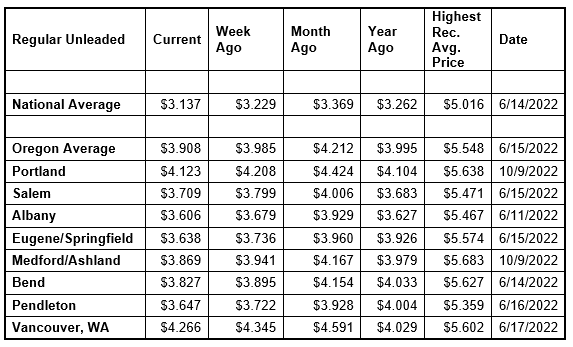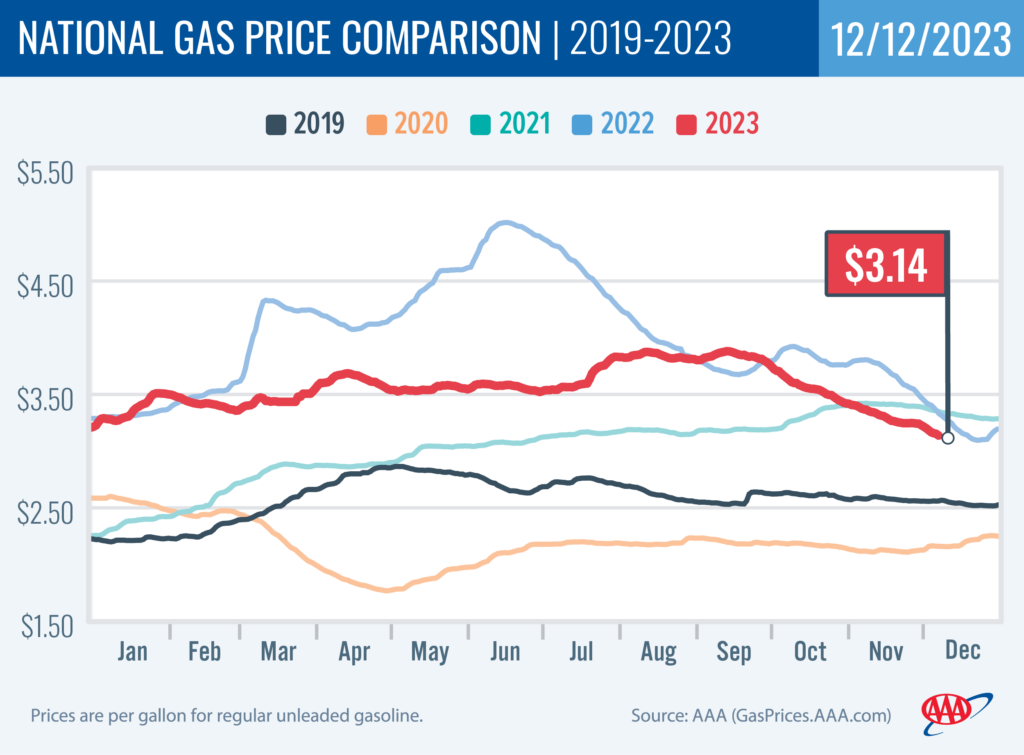Downward trend continues: Oregon, US drivers get early holiday gift of lower gas prices

PORTLAND, Ore., (KTVZ) – Gas prices continue their downward movement in all 50 states as the holidays approach, AAA Oregon/Idaho reported Tuesday. Most gas stations in Oregon are now selling regular gas for less than $4 a gallon, and nationwide, about 60% of all fuel locations have gas below $3 a gallon.
Lower crude oil costs and the typical lower demand for gas this time of year are the driving factors behind lower pump prices. For the week, the national average for regular drops nine cents to $3.14 a gallon. The Oregon average falls eight cents to $3.91.

“Drivers are enjoying lower pump prices in time for holiday shopping and travel. Gas prices should continue to decline this month, as holiday travelers hit the road for Christmas and New Year’s,” says Marie Dodds, public affairs director for AAA Oregon/Idaho.
The national average is at its lowest price since December 2022. The Oregon average is at its lowest price since last March.
The national average for regular has been steadily falling since reaching its year-to-date high of $3.88 on September 18. The Oregon average has been moving lower since reaching its year-to-date high of $4.77 on August 30.
AAA projects 2023 to be the second-busiest for holiday travel since 2000 when AAA began tracking holiday travel, only behind 2019. AAA projects 115.2 million Americans (33.8% of the population) will travel 50 miles or more for the Christmas and New Year holidays. This is up 2.2% from 2022. About 1.63 million Oregonians will pack their sleighs for a holiday trip. Find all the details and tips for travelers in the AAA holiday travel news release.
Twenty-two Oregon counties have averages below $4 a gallon:
Baker $3.77
Benton $3.56
Crook $3.92
Deschutes $3.80
Douglas $3.71
Gilliam $3.70
Hood River $3.75
Jackson $3.87
Jefferson $3.63
Klamath $3.83
Lane $3.63
Lincoln $3.43
Linn $3.60
Malheur $3.62
Marion $3.68
Morrow $3.65
Polk $3.71
Sherman $3.99
Umatilla $3.66
Union $3.66
Wasco $3.87
Yamhill $3.79
Crude oil prices declined just a week after OPEC+ (Organization of the Petroleum Exporting Countries and allies such as Russia) announced additional voluntary oil production cuts of 900,000 barrels a day, and Saudi Arabia said it would continue its cuts of a million barrels a day through March. Crude oil prices jumped ahead of the announcement, but then fell and have remained in the upper $60s to lower $70s.
Crude oil prices were volatile at the start of the conflict between Israel and Hamas in October. Fears that the conflict could escalate across the Middle East sent crude oil prices near $90 per barrel in October. Crude prices fell into the $70s on November 7, and dipped below $70 last week. While Israel and the Palestinian territory are not oil producers, there were concerns that the conflict could spread in the Middle East, which could impact crude production in other oil-producing nations in the region.
Crude oil prices tend to rise when there are geo-political events involving oil producers. Crude prices spiked after the invasion of Ukraine by Russia last year because Russia is one of the world’s top oil producers, behind the U.S. and Saudi Arabia. Crude prices also surge on news of production cuts by major oil producers. Crude oil prices spiked above $90 per barrel in mid-September, the highest price since last November, in response to the announcement from Saudi Arabia and Russia that they would keep their production cuts in place through 2023. The cuts are one million barrels a day by Saudi Arabia and 300,000 barrels a day by Russia.
Gas prices normally decline in the fall, in part due to a drop in demand for gasoline compared to the summer months and the switch from summer-blend gas to winter-blend gas. Winter-blend gas is cheaper to produce than summer-blend fuel as it contains ingredients such as butane, so gas prices normally fall when the switch occurs. Summer-blend gas helps reduce emissions from gasoline during the warm summer months. More info on summer- and winter-blend gasoline can be found at the EPA website. The switch occurs on September 15 except California, which normally keeps summer-blend gasoline until October 31. This year, California allowed the switch to occur earlier because of refinery issues in that state that sent pump prices soaring on the West Coast in late September.
Crude oil is trading around $69 today compared to $72 a week ago and $73 a year ago. So far this year, West Texas Intermediate has ranged between $63 and $94 per barrel. Crude reached recent highs of $123.70 on March 8, 2022, shortly after the Russian invasion of Ukraine, and $122.11 per barrel on June 8, 2022. The all-time high for WTI crude oil is $147.27 in July 2008.
Crude oil is the main ingredient in gasoline and diesel, so pump prices are impacted by crude prices on the global markets. On average, about 57% of what we pay for in a gallon of gasoline is for the price of crude oil, 7% is refining, 22% distribution and marketing, and 14% are taxes, according to the U.S. Energy Information Administration.
Demand for gas in the U.S. increased slightly from 8.21 to 8.47 million b/d for the week ending December 1, according to the U.S. Energy Information Administration (EIA). This compares to 8.36 million b/d at the same time last year. Meanwhile, total domestic gasoline stocks increased significantly by 5.4 million bbl to 223.6 million bbl.
Relatively low gas demand and supply growth have helped push pump prices lower. If oil prices remain low, drivers can expect pump prices to do the same during the holiday season.
Quick stats
All 50 states and the District of Columbia have lower prices now than a week ago. Florida (-16 cents has the biggest weekly drop. Hawaii (-1 cent) has the smallest.
California ($4.70) has the most expensive gas in the nation for the 20th week in a row. Hawaii ($4.70) is second, Washington ($4.26) is third, and Nevada ($4.02) is fourth. These are the four states with averages at or above $4, same as a week ago. This week 23 states and the District of Columbia have averages in the $3-range. Twenty-three states have averages in the $2 range this week.
The cheapest gas in the nation is in Texas ($2.60) and Mississippi ($2.67). No state has had an average below $2 a gallon since January 7, 2021, when Mississippi and Texas were below that threshold.
The difference between the most expensive and least expensive states is $2.10 this week, compared to $2.07 a week ago.
Oregon is one of 48 states and the District of Columbia with lower prices now than a month ago. The national average is 23 cents less and the Oregon average is 30 cents less than a month ago. Utah (-55 cents) has the largest monthly drop. Hawaii (-4 cents) has the smallest. Georgia (+16 cents) and Delaware (+3 cents) are the only states with month-over-month increases.
Oregon is one of 47 states and the District of Columbia with lower prices now than a year ago. The national average is 13 cents less and the Oregon average is nine cents less than a year ago. Utah (-64 cents) has the largest yearly decrease. California (+17 cents has the largest yearly increase.
West Coast
The West Coast region continues to have the most expensive pump prices in the nation with six of the seven states in the top 10. It’s typical for the West Coast to have six or seven states in the top 10 as this region tends to consistently have fairly tight supplies, consuming about as much gasoline as is produced. In addition, this region is located relatively far from parts of the country where oil drilling, production and refining occurs, so transportation costs are higher. And environmental programs in this region add to the cost of production, storage and distribution.
| Rank | Region | Price on 12/12/23 |
| 1 | California | $4.70 |
| 2 | Hawaii | $4.70 |
| 3 | Washington | $4.26 |
| 4 | Nevada | $4.02 |
| 5 | Oregon | $3.91 |
| 6 | Alaska | $3.81 |
| 7 | Pennsylvania | $3.49 |
| 8 | New York | $3.47 |
| 9 | Idaho | $3.43 |
| 10 | Vermont | $3.41 |
As mentioned above, California has the most expensive gas in the country. Hawaii, Washington, Nevada, Oregon, and Alaska round out the top six. Arizona is 13th. Oregon is fifth most expensive for the eighth week in a row.
Like every other state in the nation, all states in the West Coast region are seeing week-over-week declines. Arizona (-12 cents) has the largest weekly drop in the region. Alaska (-10 cents), California (-8 cents), Oregon (-8 cents), Nevada (-7 cents), Washington (-6 cents), and Hawaii (-1 cent) are also seeing weekly declines.
The refinery utilization rate on the West Coast rose from 81.8% to 85.4% for the week ending December 1. This rate has ranged between about 73% to 96% in the last year. The latest national refinery utilization rate rose from 89.8% to 90.5%.
According to EIA’s latest weekly report, total gas stocks in the region climbed from 26.76 to 27.64 million bbl.
A higher refinery utilization rate and an increase in gasoline stocks can put downward pressure on pump prices.
Oil market dynamics
Crude oil prices declined last week due to market concerns that lackluster demand could continue to push supply up while prices slide through the remainder of 2023. Additionally, the EIA reported that total domestic commercial crude inventories increased by 1.6 million bbl to 449.7 million bbl last week.
At the close of Friday’s formal trading session, WTI added $1.89 to settle at $71.23. At the close of Monday’s formal trading session, WTI ticked up nine cents to settle at $71.32. Today crude is trading around $69 compared to $72 a week ago. Crude prices are about the same as a year ago.
Drivers can find current gas prices along their route with the free AAA Mobile app for iPhone, iPad and Android. The app can also be used to map a route, find discounts, book a hotel and access AAA roadside assistance. Learn more at AAA.com/mobile.

Diesel
For the week, the national average falls nine cents to $4.09 a gallon. The record high is $5.816 set on June 19, 2022. The Oregon average loses eight cents to $4.52. The record high is $6.47 set on July 3, 2022. A year ago the national average for diesel was $4.92 and the Oregon average was $5.11.
Find current fuel prices at GasPrices.AAA.com.



